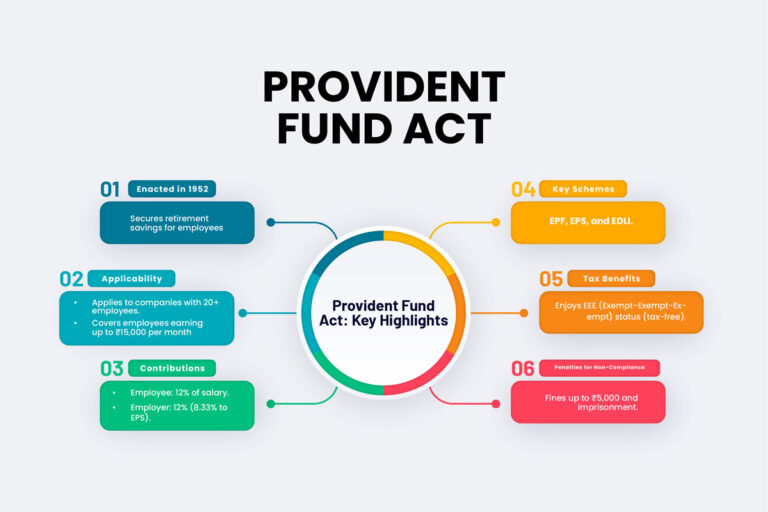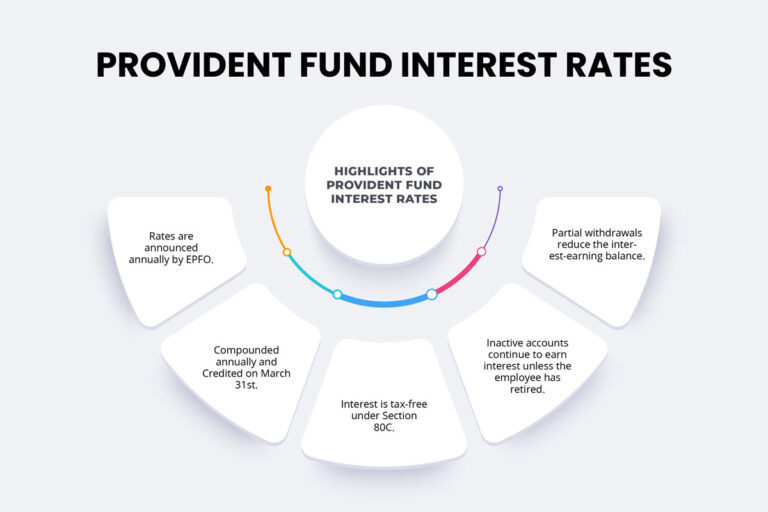The Public Provident Fund Scheme (PPF) is one of India’s most popular and reliable long-term savings schemes. Launched in 1968 by the Government of India, it offers a combination of secure returns, tax benefits, and low-risk investment options, making it ideal for anyone looking to build a retirement fund or save for future financial goals. This article covers everything you need to know about the PPF scheme, from its benefits and interest rates to the withdrawal process and tax advantages.
What is the Public Provident Fund Scheme?
The Public Provident Fund (PPF) is a savings scheme backed by the Indian government that offers guaranteed returns along with tax benefits. It allows individuals to deposit a minimum of ₹500 and a maximum of ₹1.5 lakh annually. The scheme has a tenure of 15 years, which can be extended in blocks of 5 years. When you open a PPF account, you contribute a fixed amount every year, and the balance earns compound interest.
PPF Interest Rates
The government sets the PPF interest rate, and is revised every quarter. As of the Quarter 2 of the financial year 2024-25, the PPF interest rate stands at 7.1%. The interest is calculated monthly but credited annually at the end of the financial year, on March 31st.
PPF Interest Rate Over inLast 5 Years
| Financial Year | Q1 (Apr – Jun) | Q2 (Jul – Sep) | Q3 (Oct – Dec) | Q4 (Jan – Mar) |
| 2023-24 | 7.1% | 7.1% | 7.1% | 7.1% |
| 2022-23 | 7.1% | 7.1% | 7.1% | 7.1% |
| 2021-22 | 7.1% | 7.1% | 7.1% | 7.1% |
| 2020-21 | 7.1% | 7.1% | 7.1% | 7.1% |
| 2019-20 | 8.0% | 7.9% | 7.9% | 7.9% |
(Source: EPFO’s official website)
Key Benefits of the PPF Scheme
The Public Provident Fund scheme offers several benefits, making it one of India’s most attractive long-term savings options.
| Benefit | Description |
| Tax Benefits of PPF | Contributions to PPF are eligible for tax deductions under Section 80C up to ₹1.5 lakh annually. Additionally, the interest earned and maturity proceeds are tax-free. |
| Safety and Security | As a government-backed scheme, PPF is risk-free and offers guaranteed returns, making it one of the safest long-term savings options. |
| Loan Against PPF | A loan can be availed against the PPF account between the 3rd and 6th financial year. The loan amount can be up to 25% of the balance at the end of the second financial year preceding the loan application. |
| Partial Withdrawal Facility | Partial withdrawals are allowed from the 7th year onwards, providing liquidity when needed. |
| Flexible Contributions | You can contribute a minimum of ₹500 and a maximum of ₹1.5 lakh per year, offering flexibility based on your financial capacity. |
| Compound Interest | The PPF account earns compound interest, which is calculated monthly and credited annually, allowing your investments to grow steadily. |
| Extension of Account | After maturity, the PPF account can be extended in blocks of 5 years with or without further contributions. |
Eligibility Criteria to Open a PPF Account
Anyone can open a PPF account as long as they reside in India. Here are some key points regarding eligibility:
- Resident Indians can open and maintain a PPF account.
- Minors can also have a PPF account, which a parent or guardian will operate.
- Non-resident Indians (NRIs) cannot open new PPF accounts but can continue contributing to existing accounts opened before they became NRIs.
Documents Required for Opening a PPF Account
To open a Public Provident Fund (PPF) account, you must provide the following documents for verification and account setup. These documents are required to ensure compliance with the Know Your Customer (KYC) norms mandated by the government.
1. Identity Proof
- Aadhaar Card (preferred)
- PAN Card
- Voter ID
- Passport
- Driving License
2. Address Proof
- Aadhaar Card
- Utility Bills (such as electricity, water, or gas bills not older than 3 months)
- Voter ID
- Passport
- Ration Card
3. PAN Card
Opening a Public Provident Fund account requires a PAN (Permanent Account Number) card. If the PAN is not provided, the application may be rejected.
4. Photographs
You are required to submit two recent passport-sized photographs for the account-opening process.
5. PPF Account Opening Form
You need to fill out the PPF account opening form, which is available at the bank or post office where you are opening the account or online through the respective bank’s website.
6. Nomination Form (Optional)
You can submit a nomination form at the time of opening the account. This form allows you to nominate one or more individuals entitled to the PPF balance in case of your demise.
7. Initial Deposit Proof
The minimum initial deposit required to open a PPF account is ₹500. Depending on the bank or post office, you must provide proof of this deposit, which can be done via cash, cheque, or online transfer.
How to Open and Manage a PPF Account
Opening and managing a Public Provident Fund (PPF) account is straightforward and can be done both online and offline through banks or post offices. Below are step-by-step guides for methods and tips on effectively managing your PPF account to maximize returns.
Steps to Open a PPF Account Online:
Many banks offer the convenient option of opening a PPF account online. This allows you to open and manage your account from the comfort of your home.
1. Log in to Your Bank’s Net Banking Portal:
- Visit the official website of your bank.
- Log in using your Net Banking credentials (User ID and Password).
2. Navigate to the PPF Account Section:
- Once logged in, go to the “Deposits” or “Investments” section.
- Select the option for Public Provident Fund (PPF) or similar.
3. Fill in the PPF Account Opening Form:
- Enter your details, including name, address, PAN, and Aadhaar number.
- Specify the nominee if required.
4. Submit KYC Documents:
- You may not need to upload documents if the bank has already verified your KYC. Otherwise, you must upload identity proof (Aadhaar or PAN), address proof, and a passport-sized photograph.
5. Initial Deposit:
- To open the account, you need to make a minimum deposit of ₹500. The maximum annual deposit is ₹1.5 lakh.
- Choose the payment mode (net banking, debit card, or UPI) to make the initial deposit.
6. Submit the Application:
- After reviewing your details and submitting the required information, click “Submit.”
- Once the process is complete, you will receive a confirmation message or email with the PPF account number.
7. Account Activation:
- Once your PPF account is opened, you can track and manage it through the same net banking portal.
Steps to Open a PPF Account Offline
1. Visit Your Nearest Bank or Post Office:
- Go to any bank or post office that offers PPF account services.
2. Collect the PPF Account Opening Form:
- Request a PPF account opening form from the bank or post office staff.
- Alternatively, you can download the form from the bank or post office’s official website and fill it out beforehand.
3. Fill Out the Form:
- Provide details such as name, address, PAN, Aadhaar, and other required information.
- Add nominee details if applicable.
4. Submit KYC Documents:
- Attach identity proof, address proof, PAN card, passport-sized photographs, and the account opening form.
5. Make the Initial Deposit:
- Deposit the minimum required amount of ₹500. You can do this via cash, cheque, or demand draft.
- You will receive a deposit receipt as proof of the transaction.
6. Account Verification and Activation:
- The bank or post office will verify your documents and details.
- Once verified, you will receive your PPF account number.
7. Passbook Issuance:
- You will be issued a PPF passbook that contains details of your account number, contributions, and balance. This passbook will be used for future deposits and withdrawals.
Tips to Manage Your PPF Account and maximise the profit
After opening your PPF account, managing it effectively to maximise your returns is crucial. Here are some tips for managing your PPF account:
- Make Regular Contributions: Ensure you deposit at least ₹500 annually to keep the account active. You can contribute up to ₹1.5 lakh in a financial year.
- Deposit Early in the Financial Year: To maximise interest earnings, make your deposits between the 1st and 5th of any month, as interest is calculated on the minimum balance between the 5th and the last day of the month.
- Monitor Your Account: You can track your PPF account balance and transactions through net banking or by checking your PPF passbook at the bank or post office.
- Use the PPF Calculator: To plan your savings, you can use a PPF calculator available on various financial websites. This helps you estimate the maturity value of your PPF account.
- Account Extension: After the 15-year tenure, you can extend the account in blocks of 5 years. This ensures your investments continue to grow.
Managing your PPF account efficiently ensures you maximise the scheme’s benefits and build a solid foundation for your long-term financial goals.
Read more: What Is Retrenchment In Labour Law?
How to Transfer Your PPF Account?
If you relocate or prefer a different service provider, you can transfer your PPF account from one bank or post office to another. The process is straightforward and typically takes a few weeks to complete.
Steps to Transfer Your PPF Account:
1. Visit the Existing Branch/Post Office:
- Go to the branch or post office where your PPF account is currently held.
2. Submit a Transfer Request:
- Request a PPF account transfer form and fill out the required details.
- Submit this form and your PPF passbook to the branch/post office.
3. Verification and Documentation:
- The existing branch will verify your details and process the request.
- The branch will forward your PPF account documents, balance information, and passbook to the new bank or post office where you want to transfer your account.
4. Confirmation from the New Branch:
- The receiving branch or post office will notify you once they receive the documents and the PPF account balance.
5. Submit KYC Documents at the New Branch:
- You may need to provide KYC documents (PAN, Aadhaar, etc.) at the new branch or post office for verification.
6. New PPF Account Number:
- A new PPF account number will be assigned, and the previous balance will be transferred to this new account.
7. Confirmation of Transfer:
- Once the transfer is complete, you will receive a confirmation, along with a new passbook or details if you choose online banking.
How to Convert a Minor PPF Account into a Major Account?
A minor’s PPF account needs to be converted into a major account when the minor reaches 18 years of age. This conversion allows the individual to manage their account independently.
Steps to Convert a Minor PPF Account into a Major Account:
1. Visit the Bank/Post Office:
- The guardian and the account holder (now an adult) must visit the bank or post office where the PPF account is maintained.
2. Submit Age Proof Documents:
- Provide proof of the minor’s age, such as a birth certificate, Aadhaar card, or school certificate, showing that the minor has turned 18.
3. Fill Out the Request Form:
- Request and fill out the form to convert the minor PPF account into a major account. This form will include details like the PPF account number and the account holder’s personal information.
4. Provide KYC Documents of the Account Holder:
- For account validation, the account holder, now an adult, must submit KYC documents such as Aadhaar, PAN, and a passport-sized photograph.
5. Update Signature Specimen:
- The new account holder must submit their signature specimen, which will be updated in the bank or post office records.
6. Account Conversion Confirmation:
- Once the documents are verified, the minor PPF account will be converted to a major account, and the account holder will receive a confirmation from the bank or post office.
How to Activate or Inactivate a PPF Account?
If no contributions are made to a PPF account for a financial year, the account becomes inactive. To enjoy the scheme’s benefits, the account must be reactivated.
Steps to Activate a PPF Account:
1. Visit the Bank/Post Office:
- Go to the branch or post office where your PPF account is held.
2. Submit Reactivation Request:
- Request a PPF account reactivation form and fill out the required details.
3. Pay the Penalty Fee:
- To reactivate your account, you must pay a penalty of ₹50 for each year it was inactive.
4. Deposit the Minimum Contribution:
- You must also make a minimum contribution of ₹500 for each inactive year along with the penalty.
5. Account Activation Confirmation:
- Once the penalty and contributions are deposited, the bank or post office will reactivate your PPF account, and you can resume making contributions.
How to Check the Balance of PPF Account Online?
Checking your PPF account balance online is simple and convenient if your account is linked with your bank’s net banking services.
Steps to Check PPF Balance Online:
1. Log in to Your Net Banking Account:
- Visit your bank’s official website or app.
- Enter your User ID and Password to access your net banking account.
2. Navigate to the PPF Section:
- Go to the Investments, Deposits, or PPF Account section in your net banking dashboard.
3. Select the PPF Account:
- Choose your PPF account from the list of accounts under the deposits/investments section.
4. View Balance and Transactions:
- Once you select your PPF account, you can view the balance, transaction history, and interest earned.
5. Download Statements:
- You can also download the PPF account statement in PDF or Excel format for a detailed view of your contributions and balance.
Most major banks provide this service, which makes it easier to manage your PPF account and track your long-term savings.
PPF Maturity and Withdrawal Process
The Public Provident Fund (PPF) has a tenure of 15 years, after which the account reaches maturity. Upon maturity, you can withdraw the entire balance or extend the account in blocks of 5 years with or without further contributions. Understanding the PPF withdrawal process is crucial for planning your long-term financial goals. There are different rules for full withdrawal, partial withdrawal, and Form C, essential for initiating withdrawals.
Full Withdrawal Rules
Once your PPF account matures after 15 years, you can withdraw the full balance, including the contributions and the interest earned over the years.
- Maturity Period: The total balance can be withdrawn after the 15-year tenure is completed.
- Extension Options: After maturity, you can extend the account in blocks of 5 years. If you do not need the full amount immediately, you can continue to earn interest on the balance during the extended period.
- No Tax on Withdrawals: The entire withdrawal amount, including the interest earned, is tax-free under the PPF scheme’s Exempt-Exempt-Exempt (EEE) tax status.
- Documentation Required: To initiate the full withdrawal process, you need to fill out Form C (Withdrawal Form) and submit it to your bank or post office. After verification, the bank or post office will process the request, and you will receive the funds.
Partial Withdrawal Rules
If you need funds before the account reaches maturity, the PPF scheme allows for partial withdrawals under certain conditions.
- Eligibility for Partial Withdrawal: You can make partial withdrawals starting from the 7th year of your PPF account.
- Withdrawal Limit: The maximum amount you can withdraw is 50% of the balance at the end of the 4th financial year immediately preceding the withdrawal year or 50% at the end of the preceding year, whichever is lower.
- Frequency of Withdrawals: Partial withdrawals are allowed only once per financial year.
- Tax Implications: Just like full withdrawals, partial withdrawals are tax-free, providing an added advantage for emergencies or large expenses without worrying about tax liabilities.
What is Form C and Its Use?
Form C is the official form required to initiate a PPF withdrawal—either full or partial. It is essential to complete this form correctly so the bank or post office can process your withdrawal request.
Sections of Form C:
Section 1: Account Details:
- In this section, you need to provide your PPF account number, the amount you wish to withdraw, and other personal details, such as the branch where the account is held.
Section 2: Declaration:
- You need to declare that the amount being withdrawn is within the permissible limits (for partial withdrawals) and that this is the only withdrawal request for the financial year.
Section 3: Office Use:
- This part is filled out by the bank or post office once they verify your account and the withdrawal request. After approval, the withdrawal amount will be credited to your bank account or issued via cheque.
How to Submit Form C:
- Visit the bank or post office where your PPF account is held.
- Fill in the required details in Form C and submit them with your PPF passbook.
- The bank or post office will verify the form. Once the process is complete, your withdrawal will be approved, and the funds will be disbursed.
Limitations of PPF
While the PPF scheme is highly beneficial, it has a few limitations:
- Long Lock-in Period: With a lock-in period of 15 years, PPF lacks liquidity compared to other investment options.
- Fixed Maximum Contribution: The maximum annual contribution is restricted to ₹1.5 lakh, which may limit the amount you can invest.
- Lower Interest Rate: The current PPF interest rate of 7.1% may be lower than that of other long-term investment options, such as equity and hybrid mutual funds.
Comparison Table: PPF vs Other Schemes
| Scheme | Interest Rate | Lock-in Period | Risk Level | Tax Benefits | Who Can Invest | Maturity/Withdrawal |
| PPF | 7.1% (2023-24) | 15 years | Low (government-backed) | EEE status (Sec 80C, tax-free interest & maturity) | All individuals | Full withdrawal after 15 years; partial after 7 years |
| NPS | Variable (market-linked) | Until retirement (60 years) | Medium to high (market-linked) | Tax deduction up to ₹2 lakh under Sec 80C & 80CCD | Salaried & self-employed | Withdraw 60% at retirement, 40% must be annuitized |
| EPF | 8.25% (2023-24) | Until retirement (58 years) | Low to moderate (some equity exposure) | EEE status (Sec 80C, tax-free interest & maturity) | Salaried employees in registered companies | Full withdrawal at retirement, partial for specific needs |
| Fixed Deposit (FD) | 5-6.5% (taxable) | 5 years (for tax-saving FD) | Low (Backed by RBI insurance scheme DICGC) | Deduction up to ₹1.5 lakh under Sec 80C, interest is taxable | All individuals | Withdraw at maturity; premature withdrawal with penalty |
| Sukanya Samriddhi Yojana (SSY) | 8.2% (Q2-2024-25) | Until the girl child turns 21 | Low (government-backed) | EEE status (Sec 80C, tax-free interest & maturity) | Parents/guardians of a girl child (below 10 years) | Full maturity at 21, partial withdrawal after 18 years |
| ELSS | Variable (market-linked) | 3 years | High (market risk) | Tax deduction up to ₹1.5 lakh under Sec 80C | All individuals | Withdraw after 3 years, no limit on amount |
Key Takeaways:
- PPF offers low-risk, fixed returns, making it suitable for conservative investors focused on long-term savings.
- NPS offers higher potential returns but with market risks and is best for those focused on retirement income.
- EPF provides retirement savings with employer contributions, benefiting salaried employees in the organized sector.
- FDs are fixed-income instruments with lower and taxable interest unless you opt for a five-year tax-saving FD.
- SSY offers higher returns than PPF but is restricted to parents of girl children.
- ELSS is a market-linked option with higher risk and shorter lock-in but offers potentially higher returns than PPF.
When comparing these schemes, PPF stands out for its security, tax-free returns, and suitability for individuals with low-risk tolerance. However, other schemes like NPS or ELSS may be better for those seeking higher returns and willing to take on more risk.
Conclusion
The Public Provident Fund (PPF) is a solid, low-risk investment option for individuals looking for long-term savings with tax benefits. Its guaranteed returns, government backing, and tax-free nature make it one of India’s safest retirement fund options. Although it has a long lock-in period, the security and tax savings it offers make it an excellent choice for risk-averse investors.
Frequently Asked Questions (FAQs)

Article by
Editorial Staff
Impact Labour Law editorial staff is a team comprised of individual writers with strong background in statutory & labour law compliance. Backed by several years of experience, our content creators aim to bring you the best knowledge and learnings related to PF, ESI, POSH Compliance, HR & Payroll management, FSSAI & more.






